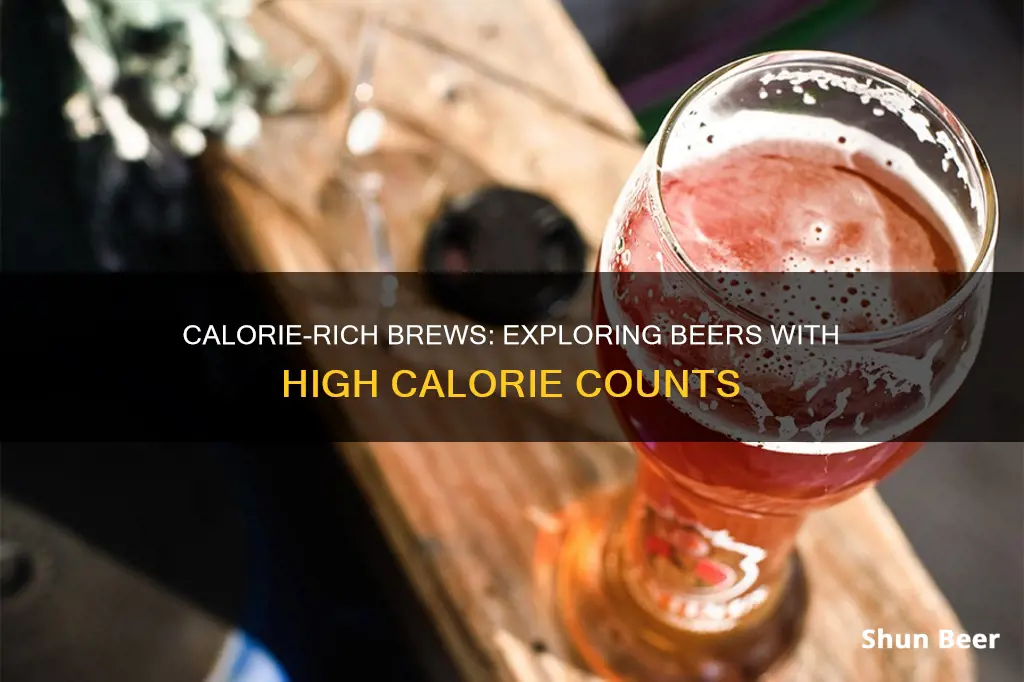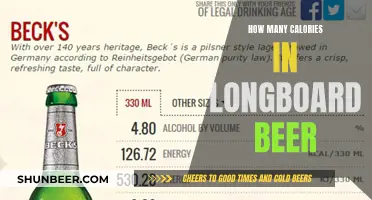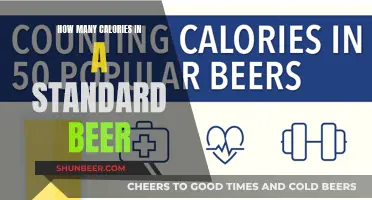
Beer is a popular drink worldwide, but some beers are far more calorie-rich than others. The calorie content of beer has been rising as brewers push the boundaries, creating stronger beers. Alcohol itself is almost as calorie-rich as pure fat, with seven calories per gram compared to fat's nine. As a result, the most calorie-rich beers tend to be high in alcohol content.
Some of the beers with the highest calories include Tusk & Grain Barrel Aged Blend with 353 calories per 12oz bottle, Leinenkugel's Big Eddy Russian Imperial Stout with 338 calories, and Samuel Adams Imperial White with 321 calories.
| Characteristics | Values |
|---|---|
| Beer with the highest calories | Tusk & Grain Barrel Aged Blend |
| Calories (per 12oz bottle) | 353 |
| Alcohol by volume | 12.5% |
| Parent company | SABMiller |
| Runner-up | Leinenkugel's Big Eddy Russian Imperial Stout |
| Calories (per 12oz bottle) | 338 |
| Alcohol by volume | 9.5% |
| Parent company | SABMiller |
What You'll Learn

High alcohol content beers have the most calories
It's no surprise that beers with a high alcohol content tend to have the most calories. Alcohol has seven calories per gram, just two fewer than pure fat, which contains nine calories per gram. In comparison, a gram of protein or carbohydrates has only four calories each. This means that while alcohol usually makes up a small share of a beer's volume, it accounts for half or more of the calories consumed by the drinker.
Beers with high alcohol content tend to be extremely strong, and brewers are constantly pushing the boundaries of what is possible. As a result, the calorie count of beers has also been increasing.
Some of the highest-calorie beers include Tusk & Grain Barrel Aged Blend with 353 calories per 12oz bottle and 12.5% ABV, Leinenkugel's Big Eddy Russian Imperial Stout with 338 calories per 12oz bottle and 9.5% ABV, and Samuel Adams Imperial White with 321 calories per 12oz bottle and 10% ABV.
Fruit-flavoured beers are also typically high in calories due to the large amounts of added sugar. For example, Redd's Wicked Mango and Redd's Wicked Apple contain 275 and 277 calories per 12oz bottle, respectively, and both have 8% ABV.
So, if you're watching your weight, it's important to be mindful of the calorie counts of different beers. Opting for light beers or those with lower alcohol content can help reduce your calorie intake.
Calories in Beer: How Many in a Tall Glass?
You may want to see also

Sweet beers often have added sugar, increasing calories
Sweet beers often have added sugar, which increases their calorie content. While beer is generally made from grains, spices, yeast, and water, some manufacturers add ingredients like honey and corn syrup to give their beer a distinctive flavour.
Beer's sugar content primarily comes from the fermentation process, where yeast converts fermentable sugars into alcohol and carbon dioxide, leaving behind varying levels of residual sugars. Different beer styles, including ales, lagers, and stouts, have distinct sugar profiles due to variations in yeast activity, brewing temperatures, and ingredients used.
The amount of sugar in beer depends on the type of beer. For example, a regular beer typically contains around 12.8 grams of carbohydrates and no sugar, as most sugars are fermented. In contrast, a light beer has around 5.9 grams of carbohydrates and 0.3 grams of sugar. Non-alcoholic beers, on the other hand, can have up to 28.5 grams of carbohydrates and sugar since the sugars are not converted into alcohol.
The calorie content of beer can vary significantly, depending on the brand and style. For instance, Samuel Adams Boston Lager has 180 calories, while Budweiser Select 55 has only 55 calories. Fruit-flavoured beers, which often contain added sugars, tend to be among the highest-calorie options. For example, Redd's Wicked Mango and Redd's Wicked Apple have 275 and 277 calories, respectively.
While beer is often associated with added inches to waistlines, it's important to note that the calorie content varies greatly between different beers. Some beers, like light beers, are crafted to be lower in calories and carbs, making them a better option for those conscious of their waistline. However, it's always good to keep in mind that even if a beer is low in sugar, the alcohol content can still contribute significantly to the overall calorie count.
Calories in Fifty Lashes Beer: A Nutritional Breakdown
You may want to see also

Imperial stouts are calorific
Imperial stouts are among the most calorific beers, with some varieties containing over 300 calories per 12oz serving. While all beers are calorific to some degree, with alcohol containing almost as many calories per gram as pure fat, certain varieties are far more likely to expand your waistline.
Alcohol Content
The primary factor influencing a beer's calorie count is its alcohol content. Alcohol contains seven calories per gram, so it follows that beers with higher alcohol by volume (ABV) will also be higher in calories. Imperial stouts tend to have a high ABV, often exceeding 8%, with some even reaching 10% or more. This high alcohol content makes imperial stouts significantly more calorific than lighter beers, which typically have an ABV of less than 5%.
Residual Sugar
In addition to alcohol content, another factor that contributes to the calorie count of imperial stouts is their high residual sugar content. The brewing process for imperial stouts often leaves a significant amount of sugar in the final product, which can further increase the calorie count. This is particularly true for sweet or pastry stouts, which can have large amounts of added sugar.
Calorie Counts
Some specific examples of imperial stouts and their calorie counts include:
- Leinenkugel's Big Eddy Russian Imperial Stout: 338 calories per 12oz bottle
- Samuel Adams Imperial Stout: 308 calories per 12oz bottle
- Sierra Nevada Bigfoot: 330 calories per 12oz bottle
- Tusk & Grain Barrel Aged Blend: 353 calories per 12oz bottle
Comparison to Other Beers
To put these numbers into perspective, a typical light beer might contain around 100 calories per 12oz serving. Even some higher-calorie beers, such as a Heineken, only clock in at around 166 calories. So, when it comes to calorie counts, imperial stouts are definitely at the higher end of the spectrum.
Light Beer vs Regular: Calorie Comparison
You may want to see also

Alcohol is almost as calorie-rich as pure fat
Beer is a popular drink in the United States, with drinking-age Americans consuming an average of about 27 gallons annually. While beer consumption is widespread, the United States is also facing an obesity epidemic, and many Americans may be unaware of the high calorie counts in beer.
Beer drinking may contribute to weight gain, and some beers are far more calorie-rich than others. For example, two Sierra Nevada Stouts contain 450 calories, equivalent to nearly a quarter of the FDA's recommended 2,000-calorie daily diet. However, it's important to note that the calorie content of beer varies significantly, with some light beers, such as Heineken Light, containing as few as 99 calories.
The high calorie content in certain beers is largely due to their alcohol content. Alcohol itself is highly calorific, with seven calories per gram, only slightly less than pure fat, which has nine calories per gram. In comparison, a gram of protein or carbohydrate has only four calories each. This means that while alcohol typically comprises a small proportion of a beer's volume, it accounts for a significant portion of the calories consumed by the drinker.
Considering the caloric density of alcohol, it's not surprising that the most calorie-rich beers also tend to have higher alcohol content. Of the beers reviewed with at least 300 calories, all had an alcohol content of more than 8%. Conversely, of the beers reviewed with less than 100 calories, all had an alcohol content of less than 5%.
In addition to their high alcohol content, many of the highest-calorie beers are also relatively sweet. While most beers have little to no added sugar, eight of the 25 highest-calorie beers are fruit-flavoured, indicating the presence of large amounts of added sugar.
So, if you're watching your weight, it's important to consider not only what you're eating but also what you're drinking. Alcohol, in any form, is a calorie-dense substance that can contribute significantly to weight gain if consumed in excess.
Sierra Nevada Torpedo Beer: Calorie Count and Nutrition Facts
You may want to see also

Beer is known for its relatively high calorie content
Calories in Beer: A Complex Matter
The calorie content of beer varies widely, ranging from as low as 55 calories per serving to over 300. The main factor influencing a beer's calorie count is its alcohol content. Alcohol is calorie-dense, containing seven calories per gram, only slightly less than pure fat, which has nine. Therefore, beers with higher alcohol content tend to be more calorific. For example, Sierra Nevada Bigfoot, a beer with 10% alcohol by volume (ABV), contains 330 calories per 12-ounce serving.
Sweet and Strong Beers Pack a Caloric Punch
Another factor that contributes to a beer's calorie count is the presence of sugar. While most beers have little added sugar, fruit-flavoured varieties and pastry stouts can contain large amounts, boosting their calorie content. Beers with higher alcohol content often have more residual sugar, resulting in a higher calorie count. Additionally, the style of beer can play a role, with stouts and imperial stouts, known for their rich, sweet flavours, tending to be more calorie-dense.
Examples of High-Calorie Brews
Some of the highest-calorie beers include Tusk & Grain Barrel Aged Blend with 353 calories per 12-ounce serving and a hefty 12.5% ABV. Samuel Adams also offers some calorie-rich options, with their Imperial Stout and Imperial White containing 308 and 321 calories, respectively. Moving away from stouts, Leinenkugel's Big Eddy series features several high-calorie beers, such as the Cherry Doppelschwarz and the Russian Imperial Stout, both clocking in at over 300 calories.
Light Beers: Lower Calorie Alternatives
On the opposite end of the spectrum, light beers offer significantly fewer calories. Heineken Light, for instance, contains only 99 calories, and Budweiser Select 55 is a waistline-friendly option with just 55 calories per serving. These beers typically have lower alcohol content, usually below 5% ABV, contributing to their reduced calorie count.
Calorie Count in Dos Equis Beer: What You Need to Know
You may want to see also
Frequently asked questions
Sierra Nevada Bigfoot, Tusk & Grain Barrel Aged Blend, Samuel Adams Imperial Stout, Samuel Adams Imperial White, and Dogfish 120 IPA are some of the highest-calorie beers.
Budweiser Select 55, Beck's Premier Light, Heineken Light, Corona Light, and Miller 64 are some of the lowest-calorie beers.
The calorie content of a beer is influenced by its alcohol content, with higher ABV beers tending to have more calories. Additionally, sweeter beers often have more calories due to added sugar.
Beer consumption can contribute to weight gain due to its calorie content, particularly when consumed in excess. Alcohol itself is calorie-dense, with 7 calories per gram, close to pure fat, which has 9 calories per gram.







